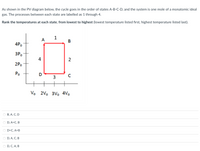Question

Transcribed Image Text:As shown in the PV diagram below, the cycle goes in the order of states A-B-C-D, and the system is one mole of a monatomic ideal
gas. The processes between each state are labelled as 1 through 4.
Rank the temperatures at each state, from lowest to highest (lowest temperature listed first, highest temperature listed last).
1
A
В
4Po
ЗРо
4
2
2Ро
Po
D
3
+
Vo 2Vo 3Vo 4V.
В, А, С, D
D, A=C, B
D=C, A=B
D, A, C, В
D, C, A, B
Expert Solution
This question has been solved!
Explore an expertly crafted, step-by-step solution for a thorough understanding of key concepts.
This is a popular solution
Trending nowThis is a popular solution!
Step by stepSolved in 2 steps

Knowledge Booster
Similar questions
- Shown below is the PV-diagram for a clockwise cycle. Determine the work done during the cycle, the heat flow during the cycle, & the change in internal energy during the cycle. W= Q= DeltaU=arrow_forward0.5 mole of an ideal monatomic gas starts from 500 point a in the diagram to the right. It undergoes a a b 400 constant pressure expansion from a to b; a constant volume compression from b to c: and an isothermal a200 compression from c to a. 200 From last week, find the three temperature values Ta, To and T. and the total work for one cycle W. Now find the heat added along the three processes 100 Qab, Qbc and Qca and the efficiency of this process. 2 4 Find the change in entropy along each process Sabı Spc and Sca and the total entrophy change. volume (m³) pressure (Pa)arrow_forwardConsider a process that uses n moles of a monatomic ideal gas operating through a Carnot cycle. The initial temperature and pressure of the gas are T1 and P1, respectively. Consider steps 1 → 2, 2 → 3, 3 → 4, and 4 → 1. In the adiabatic heating, the temperature of the gas is doubled. Write an expression for the volume V3 after this step in terms of V1. Write an expression for P3 in terms of n, R, T3 and V3.arrow_forward
- I need the answers for d-f but please also answer a-c as well.arrow_forwardA heat engine operates under the following thermodynamic cycle:A→B: isobaric expansion(P=const.)B→C: isochoric cooling(V=const.)C→A: isothermal compression(T=const.)The engine is operated by nmoles of oxygen, a diatomicgas which behaves like an ideal gas without any appreciable vibrational kinetic energy.The thermodynamic cycle described by the gas is entirely defined by pressures PAand PC, and volume VA. Assume that PC=PA/2and give all your answers in terms of n, R, PAand VA. b)Sketch the cycle on a P-Vdiagram and determine all the unknown pressures, volumes and temperatures. c)Determine the efficiency of this engine, defined by e =Wnet/Qin.Wnetis the net work done by the gas over a full cycle and Qinis the total heat that flows into the gas.Be careful, Qindoes not include the heat released by the gas.arrow_forwardQuestion B: A sample of 1.00 mole of a diatomic ideal gas is initially at temperature 265 K and volume 0.200 m3. The gas first undergoes an isobaric expansion, such that its temperature increases by 110.0 K. It then undergoes an adiabatic expansion so that its final volume is 0,440 m3. i. Sketch a PV diagram for the two-step process, including labeled initial, final, and intermediate states, and a two-part curve/path with an arrow indicating direction. Label the initial state "i", the final state "f", and the intermediate state "b". Write down the known values for P, T, and V at each point, e.g. T; = 265 K, and Th = 375 K. (B.1) What is the initial pressure of the gas, Pi, in pascals [Pa]? Pi = Pa Enter a number. (B.2) What is the total heat transfer, Q, to the gas, in joules [J]? Q = Qtotal = (B.3) What is the total work done on the gas, w, in joules [J]? w = Wtotal = Enter your answer for problem (B.3) for credit. First, use the following questions as intermediate steps; answers can…arrow_forward
- A certain gasoline engine is modeled as a monatomic ideal gas undergoing an Otto cycle, represented by the p-V diagram shown in the figure. The initial pressure, volume, and temperature are p1 = 1.05 × 105 Pa, V1 = 0.035 m3, and T1 = 290 K, respectively. a)The first step in the Otto cycle is adiabatic compression. Enter an expression for the work performed on the gas during the first step, in terms of V1, V2, and p1. b) Calculate the temperature of the gas, in kelvins, at the end of the first step. c)The fourth and last step in the Otto cycle is isochoric cooling to the initial conditions. Find the amount of heat, in joules, that is discharged by the gas during the fourth step.arrow_forwardAn ideal gas undergoes the thermodynamic process shown in the ??PV diagram in the figure. Determine whether each of the values (a) Δ?ΔU, (b) ?W, (c) ?Q for the gas is positive, negative, or zero. (Note that ?W is the work done ??on the gas.) Hint: First use the ideal gas law to find the initial and final temperatures in terms of ?0P0 and ?0V0 and determine if the final temperature is greater than, less than, or equal to the initial temperature. (a) ΔU A.+ B.- C.0 (b) W A.+ B.- C.0 (c) Q A.+ B.- C.0arrow_forwardYou would like to raise the temperature of an ideal gas from 295 K to 960 K in an adiabatic process. a)What compression ratio will do the job for a monatomic gas? b)What compression ratio will do the job for a diatomic gas?arrow_forward
arrow_back_ios
arrow_forward_ios